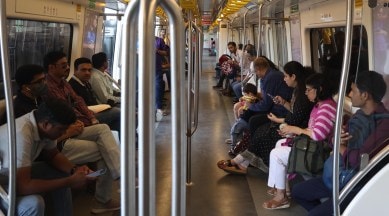Stay updated with the latest - Click here to follow us on Instagram
Mumbai Metro Impact: Ridership on suburban local trains dip
Mumbai metro impact on Mumbai local trains: As per Western Railway (WR) data, ridership at Dahisar station from January 12 to 19 was 5,18,517 while between January 20 and 26 it was 3,47,838, falling by 1,70,679.

Ridership on Mumbai’s suburban local trains on the Western Line is gradually falling after the opening of Metro Lines 2A and 7. Ridership at Andheri and Dahisar stations has dropped compared to the week before the new Metro lines were inaugurated.
As per Western Railway (WR) data, ridership at Dahisar station from January 12 to 19 was 5,18,517 while between January 20 and 26 it was 3,47,838, falling by 1,70,679.
The total ridership at Dahisar from January 12 to 26 was 8,66,355.
Prime Minister Narendra Modi inaugurated the Metro lines on January 19. The lines were opened to the public on January 20.
Similarly at Andheri station, ridership from January 12 to 19 was 16,73,112. Between January 20 and 26 it was 11,99,666, falling by 4,73,446. The total ridership at Andheri from January 12 till 26 is 28,72,778.
WR officials, however, said it is too early to comment on the impact of the new Metro lines on railway ridership as commuters will travel on the Metro, assess their travel needs and eventually choose what suits their daily commute best.
Commuters using Metro One, between Ghatkopar and Versova, previously alighted at Andheri station to go to western suburbs like Dahisar and Goregaon on the WR line. With the start of the new Metro lines, commuters can get down at WEH on Line One and travel to Dahisar on Line 7 or they can go to DN Nagar station and use Line 2A through interchange station Gundavali in Andheri east to go to the western suburbs.
Dahisar is the common station connecting both 2A and 7.
“I have shifted to Metro. Earlier I used to travel by local train to Andheri from Malad, However, with the Metro lines, it is just a walk from the Metro station and I reach Andheri station seamlessly. I had bought an AC local train pass. However, during peak hours AC local trains are equally crowded which was not the case earlier. I travelled for a week on the Metro and it was a stress-free experience,” Harish Marchetty said.
Metro Lines 2A and 7 cover a 35-km distance between Andheri and Dahisar on the east and west of suburban Mumbai passing through Link Road and Western Express Highway (WEH).
The objective to introduce the Metro on this densely populated route was to take the load off the suburban local trains and vehicular traffic.
As per the MMRDA, both 2A and 7 are expected to reduce 25 per cent vehicular traffic and take 10-15 per cent of the load off local trains.
In just a week’s time, 2A and 7 have recorded over 10 lakh ridership since their inauguration by Modi and commencement of commercial operations from the next day.
Both Metro lines cover 30 stations and services during peak time are available at an eight-minute gap and during non-peak hours at a 9-10 minutes gap. There are a total 22 rakes operating on these lines.